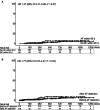Atrial Fibrillation Detection and Ischemic Stroke Recurrence in Cryptogenic Stroke: A Retrospective, Multicenter, Observational Study
- PMID: 38240210
- PMCID: PMC11056161
- DOI: 10.1161/JAHA.123.031508
Atrial Fibrillation Detection and Ischemic Stroke Recurrence in Cryptogenic Stroke: A Retrospective, Multicenter, Observational Study
Abstract
Background: Atrial fibrillation (AF) is known to be a strong risk factor for stroke. However, the risk of stroke recurrence in patients with cryptogenic stroke with AF detected after stroke by an insertable cardiac monitor (ICM) is not well known. We sought to evaluate the risk of ischemic stroke recurrence in patients with cryptogenic stroke with and without ICM-detected AF.
Methods and results: We retrospectively reviewed patients with cryptogenic stroke who underwent ICM implantation at 8 stroke centers in Japan. Cox regression models were developed using landmark analysis and time-dependent analysis. We set the target sample size at 300 patients based on our estimate of the annualized incidence of ischemic stroke recurrence to be 3% in patients without AF detection and 9% in patients with AF detection. Of the 370 patients, 121 were found to have AF, and 110 received anticoagulation therapy after AF detection. The incidence of ischemic stroke recurrence was 4.0% in 249 patients without AF detection and 5.8% in 121 patients with AF detection (P=0.45). In a landmark analysis, the risk of ischemic stroke recurrence was not higher in patients with AF detected ≤90 days than in those without (hazard ratio, 1.47 [95% CI, 0.41-5.28]). In a time-dependent analysis, the risk of ischemic stroke recurrence did not increase after AF detection (hazard ratio, 1.77 [95% CI, 0.70-4.47]).
Conclusions: The risk of ischemic stroke recurrence in patients with cryptogenic stroke with ICM-detected AF, 90% of whom were subsequently anticoagulated, was not higher than in those without ICM-detected AF.
Keywords: atrial fibrillation; cryptogenic stroke; ischemic stroke.
Figures



Similar articles
-
Higher Frequency of Premature Atrial Contractions Correlates With Atrial Fibrillation Detection after Cryptogenic Stroke.Stroke. 2024 Apr;55(4):946-953. doi: 10.1161/STROKEAHA.123.044813. Epub 2024 Mar 4. Stroke. 2024. PMID: 38436115
-
MR-imaging pattern is not a predictor of occult atrial fibrillation in patients with cryptogenic stroke.J Neurol. 2019 Dec;266(12):3058-3064. doi: 10.1007/s00415-019-09524-5. Epub 2019 Sep 11. J Neurol. 2019. PMID: 31511980 Free PMC article.
-
High Detection Rate of Atrial Fibrillation With Insertable Cardiac Monitor Implantation in Patients With Cryptogenic Stroke Diagnosed by Magnetic Resonance Imaging.J Stroke Cerebrovasc Dis. 2019 Sep;28(9):2569-2573. doi: 10.1016/j.jstrokecerebrovasdis.2019.05.023. Epub 2019 Jun 21. J Stroke Cerebrovasc Dis. 2019. PMID: 31230824
-
Detection of Atrial Fibrillation after Ischemic Stroke with an Insertable Cardiac Monitor: A Systematic Review and Individual Patient Data Meta-Analysis of Randomized Clinical Trials.Cerebrovasc Dis. 2024;53(3):316-326. doi: 10.1159/000533265. Epub 2023 Jul 29. Cerebrovasc Dis. 2024. PMID: 37517392
-
Value of HAVOC and Brown ESUS-AF scores for atrial fibrillation on implantable cardiac monitors after embolic stroke of undetermined source.J Stroke Cerebrovasc Dis. 2024 Jan;33(1):107451. doi: 10.1016/j.jstrokecerebrovasdis.2023.107451. Epub 2023 Nov 22. J Stroke Cerebrovasc Dis. 2024. PMID: 37995501 Review.
Cited by
-
Atrial fibrillation in Retinal Artery Occlusions.Cardiol Cardiovasc Med. 2025;9(4):234-247. Epub 2025 Jul 7. Cardiol Cardiovasc Med. 2025. PMID: 40761687 Free PMC article.
-
Short-duration atrial fibrillation in ischemic stroke: high risk despite subclinical burden-a prospective cohort study.BMC Cardiovasc Disord. 2025 Aug 20;25(1):616. doi: 10.1186/s12872-025-05080-1. BMC Cardiovasc Disord. 2025. PMID: 40835907 Free PMC article.
-
Subclinical Atrial Fibrillation and Stroke Risk: Time to Put the Horse Back in Front of the Cart?J Am Heart Assoc. 2024 Feb 6;13(3):e033349. doi: 10.1161/JAHA.123.033349. Epub 2024 Jan 19. J Am Heart Assoc. 2024. PMID: 38240297 Free PMC article. No abstract available.
-
The Importance of Timing in Performing a Holter ECG in Patients Diagnosed with an Embolic Stroke of Undetermined Source.Biomedicines. 2025 Mar 21;13(4):771. doi: 10.3390/biomedicines13040771. Biomedicines. 2025. PMID: 40299323 Free PMC article.
-
A Year in Review: Atrial Fibrillation 2024.J Innov Card Rhythm Manag. 2025 Jan 15;16(1):6136-6140. doi: 10.19102/icrm.2025.16016. eCollection 2025 Jan. J Innov Card Rhythm Manag. 2025. PMID: 39897725 Free PMC article. No abstract available.
References
-
- Hart RG, Diener HC, Coutts SB, Easton JD, Granger CB, O'Donnell MJ, Sacco RL, Connolly SJ; Cryptogenic Stroke/ESUS International Working Group . Embolic strokes of undetermined source: the case for a new clinical construct. Lancet Neurol. 2014;13:429–438. doi: 10.1016/S1474-4422(13)70310-7 - DOI - PubMed
-
- Kimura K, Minematsu K, Yamaguchi T. Japan Multicenter Stroke Investigators' Collaboration (J‐MUSIC). Atrial fibrillation as a predictive factor for severe stroke and early death in 15,831 patients with acute ischaemic stroke. J Neurol Neurosurg Psychiatry. 2005;76:679–683. doi: 10.1136/jnnp.2004.048827 - DOI - PMC - PubMed
Publication types
MeSH terms
LinkOut - more resources
Full Text Sources
Medical

